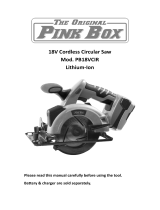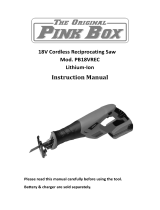
Page 4 For technical questions, please call 1-800-444-3353. Item 68852
Battery tool use and care
1. Recharge only with the charger specified by
the manufacturer. A charger that is suitable
for one type of battery pack may create a risk
of fire when used with another battery pack.
2. Use power tools only with specifically
designated battery packs. Use of any other
battery packs may create a risk of injury and fire.
3. When battery pack is not in use, keep it away
from other metal objects, like paper clips,
coins, keys, nails, screws or other small metal
objects, that can make a connection from
one terminal to another. Shorting the battery
terminals together may cause burns or a fire.
4. Under abusive conditions, liquid may be
ejected from the battery; avoid contact.
If contact accidentally occurs, flush with water.
If liquid contacts eyes, additionally seek
medical help. Liquid ejected from the
battery may cause irritation or burns.
Service
Have your power tool serviced by a qualified repair person using only identical replacement parts.
This will ensure that the safety of the power tool is maintained.
Reciprocating Saw Safety Warnings
1. Hold power tool by insulated gripping surfaces
when performing an operation where cutting
tool may contact hidden wiring. Contact with
a ″live″ wire will make exposed metal parts
of the tool ″live″ and shock the operator.
2. Use clamps or another practical way to secure
and support the work piece to a stable platform.
Holding the work by hand or against your body
leaves it unstable and may lead to loss of control.
3. Maintain labels and nameplates on the tool.
These carry important safety information.
If unreadable or missing, contact
Harbor Freight Tools for a replacement.
4. Avoid unintentional starting.
Prepare to begin work before turning on the tool.
5. Do not lay the tool down until it has come to
a complete stop. Moving parts can grab the
surface and pull the tool out of your control.
6. When using a handheld power tool,
maintain a firm grip on the tool with both
hands to resist starting torque.
7. Do not leave the tool unattended when the
Battery Pack is connected. Turn off the tool,
and remove the Battery Pack before leaving.
8. The battery Charger gets hot during use.
The Charger’s heat can build up to unsafe
levels and create a fire hazard if it does
not receive adequate ventilation, due to
an electrical fault, or if it is used in a hot environment.
Do not place the Charger on a flammable surface.
Do not obstruct any vents on the Charger.
Especially avoid placing the Charger on carpets
and rugs; they are not only flammable, but they
also obstruct vents under the Charger.
Place the Charger on a stable, solid, nonflammable
surface (such as a stable metal workbench or
concrete floor) at least 1 foot away from all flammable
objects, such as drapes or walls. Keep a fire
extinguisher and a smoke detector in the area.
Frequently monitor the Charger and
Battery Pack while charging.
9. This product is not a toy.
Keep it out of reach of children.
10. People with pacemakers should consult their
physician(s) before use. Electromagnetic fields in
close proximity to heart pacemaker could cause
pacemaker interference or pacemaker failure.
In addition, people with pacemakers should:
• Avoid operating alone.
• Do not use with power switch locked on.
• Properly maintain and inspect
to avoid electrical shock.
11. WARNING: Some dust created by power sanding,
sawing, grinding, drilling, and other construction
activities, contains chemicals known [to the State
of California] to cause cancer, birth defects or
other reproductive harm. Some examples of
these chemicals are:
• Lead from lead-based paints
• Crystalline silica from bricks and cement or
other masonry products
• Arsenic and chromium from
chemically treated lumber
Your risk from these exposures varies, depending on
how often you do this type of work. To reduce your
SAFETY OPERATION MAINTENANCESETUP














